The Chinese economy has entered an adjustment phase after registering double-digit growth rates for five consecutive years starting in 2003. Even so, compared to the United States, which is experiencing a serious financial crisis, and Japan and Europe, which have been severely hit by the spillover effects, China seems to remain buoyant and the phenomenon of economic decoupling seems apparent.
Loose linkage between growth rates of the U.S. and Chinese economies
The subprime mortgage crisis has triggered a sharp downturn in the U.S. economy, but its impact on the Chinese economy is expected to be limited. According to IMF estimates, the elasticity of China's growth rate to the U.S. growth rate is the lowest among Asian countries and Asian regions at just 0.1%, which is lower than the 0.3% figure for Japan ( figure 1 ). The elasticity figures tell us that should the U.S. growth rate fall by 1%, Japan's growth rate would be pulled down by 0.3% while the rate of growth of the Chinese economy would fall by only 0.1%.
Figure 1:The impact of fluctuations of the U.S. growth rate on the growth rates of Asian economies*
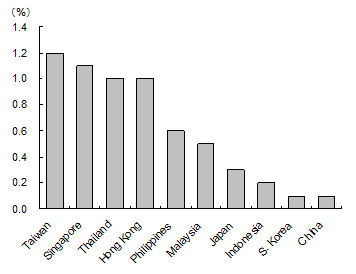
*Elasticity: Indicates the percentage change in the growth rate of the country concerned in the event of a 1% rise in the U.S. growth rate.
(Source) Based on IMF, Regional Economic Outlook Asia and Pacific, April 2008 (Table 2.11, cross country regressions).
China's dependence on exports to the U.S., as a percentage of GDP, is much higher than that of Japan; however, the correlation between Chinese and U.S. GDP growth is lower than that between Japan and the U.S. ( figure 2 ) due to the reasons outlined below.
Figure 2: Changes in the GDP growth rates of Japan, the U.S. and China
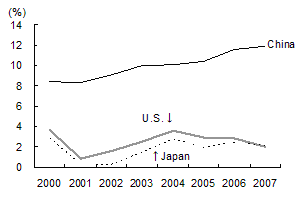
(Source) Based on IMF, World Economic Outlook , Oct. 2008.
First, China's dependence on exports to the U.S. is not as high as it seems. In China, tradable goods (imports and exports) change hands at international prices, but prices of non-tradable goods (services) are much lower than in advanced nations such as Japan. Calculated based on GDP adjusted for purchasing power parity (PPP), China's dependence on exports to the U.S. is much closer to that of Japan ( figure 3 ).
Second, half of China's foreign trade is processing trade, with exported products containing more components and intermediate goods imported from overseas than value added in China, whereas the import content of Japan's exports is comparatively low. Taking this into consideration, China should be much less dependent than Japan on the U.S. economy.
Figure 3: Dependence on US exports in China and Japan
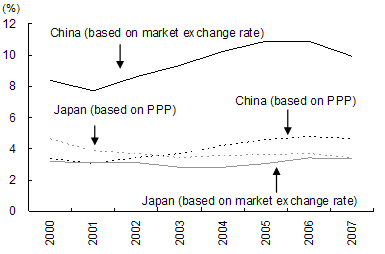
(Note) A particular country's dependence on exports to the U.S. is calculated by dividing exports to the U.S. by GDP (GDP based on market exchange rates or PPP). U.S. imports from China and Japan are used as substitutes for their respective exports to the U.S.
(Source) Based on U.S. Census Bureau and IMF data.
Third, because China has strict regulations on capital transactions, private capital movement is limited. In particular, China's securities market is only partially open to foreign participation and stock prices are influenced more by domestic factors than foreign ones, with their linkage to overseas markets not particularly high. According to estimation by the IMF based on data for 2000-07, the correlation coefficient between stock prices in Japan and the U.S. was 0.52, whereas that between stock prices in China and the U.S. was only 0.08. Indeed, while the Shanghai Composite Index recorded the largest decline among major global markets by plunging 70% from an all-time high in October 2007 to mid-September 2008 when Lehman Brothers filed for bankruptcy, since then the Shanghai market has remained comparatively stable while stock prices on other major global markets have plummeted ( figure 4 ). Also, Chinese financial institutions hold few foreign currency assets and have to a large extent been sheltered from the direct impact of the recent subprime mortgage meltdown.
Figure 4: Loose linkage between stock prices in China and major global markets
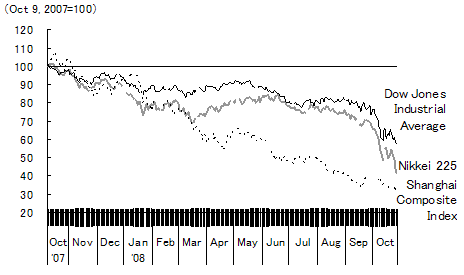
(Source) Based on data provided by Bloomberg.
Still plenty of policy options
While the Chinese economy has been slowing down on the back of deteriorating domestic and global conditions, the Chinese government still has enough leeway to launch a raft of economic stimulus measures, including both monetary and fiscal policies.
First, with the economy losing steam, inflation is subsiding. So far, the inflation rate (CPI, year-on-year) has shown a tendency to follow movements in the economic growth rate (year-on-year) with a lag of around three quarters ( figure 5 ). In the third quarter of 2008, the year-on-year growth rate was 9.0%, down 3.6% from the second quarter of last year when it peaked at 12.6%. The inflation rate was 5.3% (4.6% in September) in the third quarter of 2008, far below the first quarter rate of 8.0% (8.7% in February). Besides the economic slowdown, the recent fall in oil prices has also eased inflationary pressure. Against this backdrop, China's central bank has cut interest rates and the minimum reserve equirement ratio twice since September ( figure 6 ). China is expected to have even greater leeway to ease monetary policy in the coming months.
Figure 5: Changes in the GDP growth rate and inflation rate
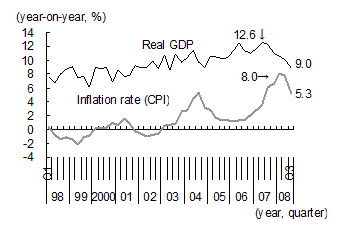
(Source) Based on data provided by the National Bureau of Statistics of China.
Figure 6: Monetary policy shifting from tightening to easing
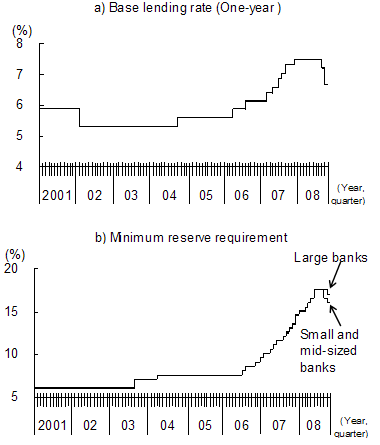
(Note) The one-point reduction in the minimum reserve requirement implemented in September 2008 applied only to deposit-taking financial institutions other than Industrial and Commercial Bank of China, Agricultural Bank of China, Bank of China, China Construction Bank, Bank of Communications, and Postal Savings Bank of China, while the minimum reserve requirement was reduced by two points for financial institutions situated in areas devastated by the Sichuan earthquake.
(Source) Based on data provided by the People's Bank of China.
Second, pressure on the RMB to appreciate is also easing. The RMB had been appreciating since last year, but leveled off after mid-July this year. The offshore RMB forward rate (NDF, one-year forward contract) has fallen sharply, and the forward premium representing the difference between the forward exchange rate and the spot exchange rate has also shrunk to around zero from earlier levels that exceeded 10% in the spring of 2008 ( figure 7 ). These changes indicate that expectations of an appreciating RMB, which were causing inflows of hot money and higher inflation, are subsiding. Consequently, China now has greater freedom in setting not only monetary policies, but also exchange rate policies that include allowing the RMB to fall.
Figure 7:RMB/Dollar Rate - Spot versus forward (NDF) exchange rates -

(Note) The RMB spot rate is directly affected by the Chinese central bank's intervention and other policies, but the offshore forward (NDF) rate largely reflects market supply and demand.
(Source) Based on data provided by Bloomberg and the State Administration of Foreign Exchange.
Third, also on the fiscal front, China has the flexibility to stimulate its economy through tax cuts and increased expenditures. In 2007, China had a fiscal surplus to GDP ratio of 1.1% and a government debt to GDP ratio of just 21.1%. In comparison, Japan had a ratio of fiscal deficit to GDP of 2.5% and a ratio of government bonds to GDP of 164.1% (both according to an IMF survey). During the Asian financial crisis of 1997-98, China actively utilized primarily expansionary fiscal policy measures to stimulate the economy. If necessary, fiscal measures will also likely be put into effect in the current crisis. The Chinese government has already announced an increase in the Export Value - Added Tax (VAT) Refund Rates for 3,486 products that will be effective from November 1, 2008. A shift from production-type VAT to consumption-type VAT starting from 2009 has also been reported, with the size of the resulting tax cut estimated at more than 150 billion RMB. ( note 1 )
Fourth, China holds foreign currency reserves amounting to $1.9 trillion. China would not face an immediate shortage of foreign currency even if its balance of payments were to deteriorate significantly as a result of efforts to expand domestic demand through expansionary monetary and fiscal policies. There is also no risk that China will fall victim to currency speculation and be forced to significantly devalue its currency as did Thailand, Korea and Indonesia during the Asian financial crisis of 1997-98.
Finally, when faced with a crisis China's system of centralized authority allows it to adapt more quickly than advanced democratic nations, which require time to form a consensus. When the Emergency Economic Stabilization Act to spend up to $700 billion of public funds on purchasing troubled assets from financial institutions was rejected by the U.S. House of Representatives on September 29, the world's financial markets were plunged into turmoil; this kind of situation is unthinkable in China.
China standing out amid a global reccession
The current global economic slowdown stemming from the fallout of the U.S.-triggered financial crisis is expected to continue into 2009. According to the IMF World Economic Outlook released in October, major economies will record slow growth in 2009 with growth rates of 0.1% in the U.S., 0.2% in the euro zone, and 0.5% in Japan. Global economic growth is expected to slow from 5.0% in 2007 and 3.9% in 2008 to 3.0% in 2009. As a result, the combined contribution to global economic growth of Japan, the U.S. and Europe will be no more than about 0.1%. In contrast, China will continue to show a tendency to slow, but nevertheless it is still expected to maintain a comparatively high growth rate of 9.3% in 2009. If we also take into account the fact that the size of China's GDP (based on purchasing power parity) is equivalent to 12.0% of global GDP, China's contribution to global economic growth will reach to 1.12% (9.3% times 12.0%), which is equivalent to almost 40% of total global growth estimated at 3.0% ( figure 8 ). ( note 2 ) Thus, the current U.S.-triggered financial crisis looks to become the event that ushers in China's emergence as a global economic power.
Figure 8:China's Contribution to Global Economic Growth
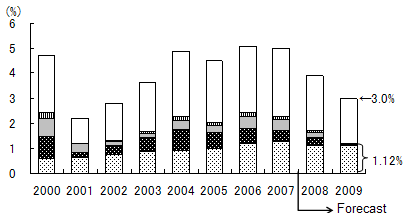
(Source) Based on IMF, World Economic Outlook , Oct. 2008.


